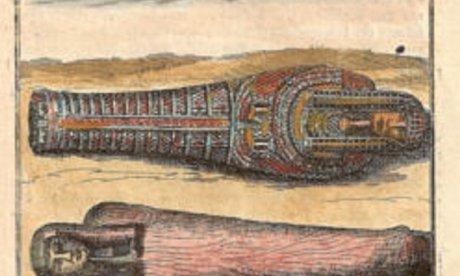Eat, Drink, and Be Mummy: Digging into Data Uncovers Surprising Health News

Egyptian Mummies (Paris, 1683)
Alain Manesson-Mallet [public domain], via Wikimedia Commons

Egyptian Mummies (Paris, 1683)
Alain Manesson-Mallet [public domain], via Wikimedia Commons
The New York Times, The Atlantic , Washington Post , Nature , Al Jazeera , BBC , USA Today, LA Times, and The Australian--to name only a few--recently featured breaking research published March 10, 2013, in the medical journal, The Lancet. The article suggests that atherosclerotic vascular disease, a disease thought to be distinctly related to the postindustrial modern age and post-paleo-agricultural lifestyles, has been lurking in the human pathology for awhile--quite awhile, in fact.
Analysis of whole body CT scans of 137 mummies from diverse geographical regions, populations, lifestyles and diets--ancient Egyptian and Peruvians, Ancestral Puebloans, and Unangans of the Aleutian Islands--spanning 4000 years, suggests that atherosclerosis is not a modern epidemic, but common in premodern societies as well. The Lancet article concludes
Atherosclerosis was common in four preindustrial populations, including a preagricultural hunter-gatherer population, and across a wide span of human history...The presence of the atherosclerosis in premodern human beings suggest that the disease is an inherent component of human ageing and not characteristic of any specific diet or lifestyle (Randall et al. 2013, 11).
Alas, such is the human condition.
However, it's to the credit of humanistic and scientific innovation that this fascinating bioarcheological discovery was made possible. The team that published The Lancet article analyzed data sets that will be made available soon by the Internet-based Mummy Picture Archive and Communication Technology Radiological Mummy Database Project, or IMPACT. Funded by a Digging into Data Challenge grant, sponsored by the NEH and SSHRC, the IMPACT Radiological Mummy Database provides researchers and scholars from all disciplines ready access to a comparative database of medical imaging of mummified human remains. Having access to large data sets of primary radiographic sources, until recently difficult to accumulate and aggregate, allows cardiologists and anthropologists, radiologists and archeologists, technologists and historians to conduct research within their fields of expertise and fosters collaboration across the Humanities and STEM fields.
Principal Investigator of the IMPACT project, Randall C. Thompson, who also co-authored The Lancet article, said, "Indeed, the multi specialty collaboration for our study is absolutely remarkable and the only way this sort of research can be accomplished. The NEH grant made it possible." As a result of the funding and the support of the NEH and SSHRC, Randall and his team look forward "to even more discoveries when we put all the data together.” IMPACT is typical of Digging in Data Challenge grant projects that develop and explore technologically inventive and computationally creative research methods that drill into massive data sets to arrive at new questions and surprising answers.
References:
Randall C. Thompson, et al., "Atherosclerosis Across 4000 Years of Human History: The Horus Study of Four Ancient Populations," The Lancet (March 10, 2013), 1-11: doi:10.1016/S0140-6736(13)60598-X

